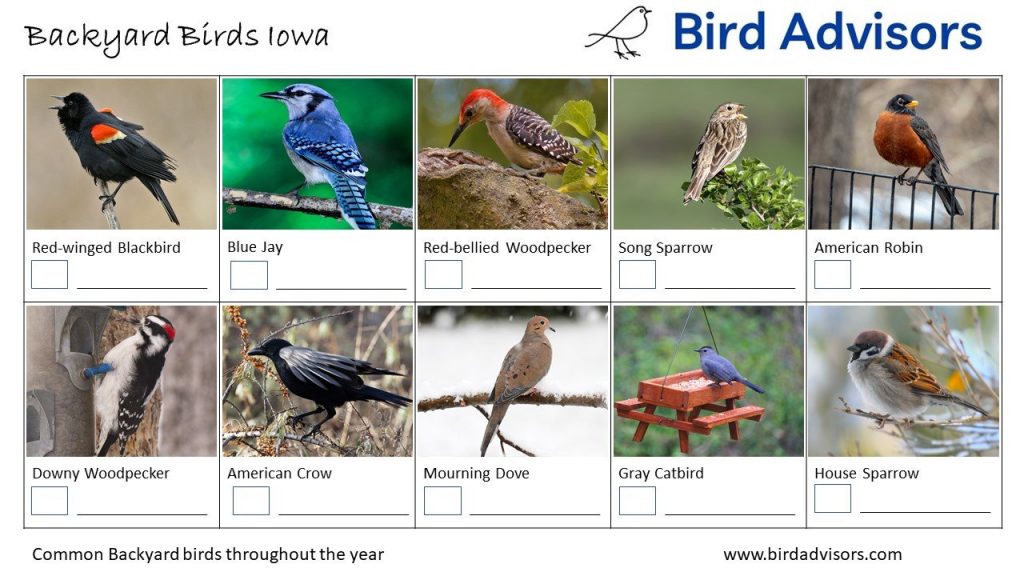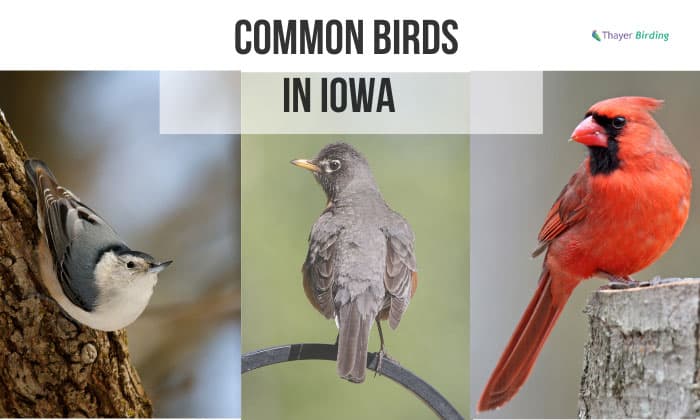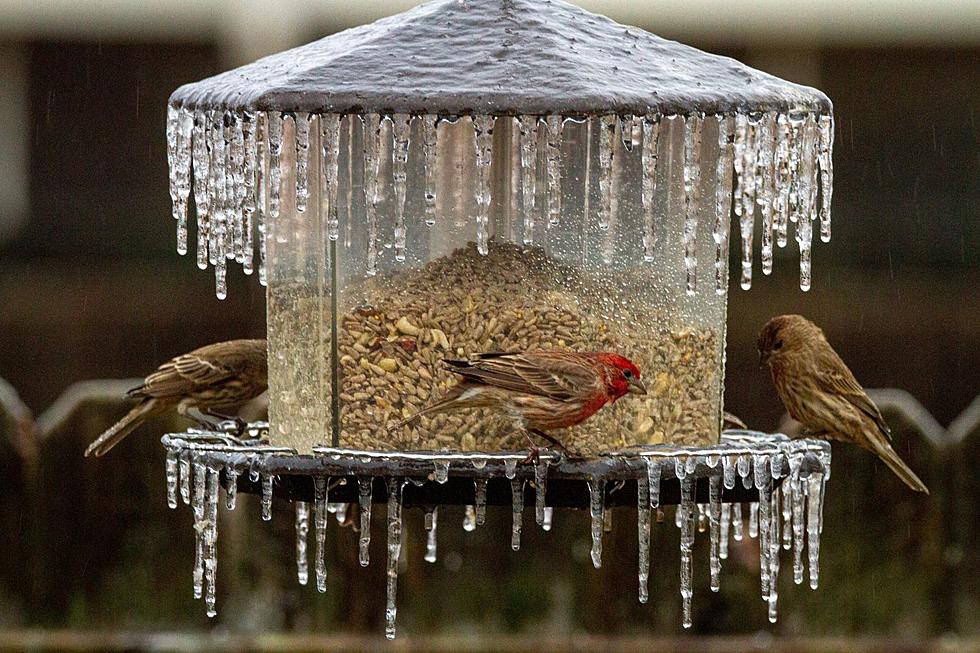“The Most Common Birds at Bird Feeders in Iowa Throughout the Year” is an article that highlights the variety of bird species commonly observed at bird feeders in Iowa. It provides a comprehensive list of the top 10 birds, such as the vibrant Northern Cardinal, the distinct Red-winged Blackbird, and the charming American Goldfinch, among others. The article also includes two engaging videos that offer an overview and detailed information about these feeder birds in Iowa. Each bird species is described in depth, including details about their habitat, behavior, identification, and preferred food at feeders. With the Northern Cardinal leading the popularity chart, the article also mentions other fascinating birds like the Mourning Dove, Downy Woodpecker, House Sparrow, and Blue Jay.
Northern Cardinal

Habitat
The Northern Cardinal, also known as the Redbird, is a common sight at bird feeders in Iowa throughout the year. These beautiful birds can be found in a variety of habitats, from urban gardens and parks to woodland edges and shrubby areas. They are also known to frequent backyard feeders, especially those with sunflower seeds.
Behavior
Northern Cardinals are known for their distinctive behaviors. They are often seen perching on tree branches or feeding on the ground. The male Cardinals are known for their vibrant red feathers, while the females have a more muted reddish-brown color. Both sexes are known for their melodious songs, which can be heard throughout the year.
Identification
The Northern Cardinal is a medium-sized bird with a crest on its head. The male has a bright red plumage, while the female has a brownish color with hints of red. Both have a distinctive black face mask and a short, stout beak. Their wings and tail also have a slight reddish tinge.
Preferred Food at Feeders
Northern Cardinals have a diverse diet, but they have a particular fondness for sunflower seeds. They also eat a variety of other seeds, fruits, and insects. Providing a mix of sunflower seeds, millet, and cracked corn in bird feeders will attract these beautiful birds to your yard.
Red-winged Blackbird
Habitat
Red-winged Blackbirds are common birds in Iowa and can be found in a variety of habitats. They are highly adaptable and can be seen in wetlands, marshes, fields, and even urban areas. With their distinctive red and yellow shoulder patches, these birds are easily recognizable.
Behavior
Female Red-winged Blackbirds are often seen perched on cattails or other tall grasses, while the males are known for their territorial behaviors. They defend their nesting territories and will display their red shoulder patches to ward off intruders. Their songs are a common sound in wetland areas.
Identification
Male Red-winged Blackbirds have glossy black feathers with bright red and yellow shoulder patches. They have a conical bill and pointed wings. Females have a streaked brown and white plumage, which helps them blend in with their surroundings.
Preferred Food at Feeders
While Red-winged Blackbirds are primarily insectivorous, they also eat seeds, fruits, and grains. To attract these birds to your feeders, provide a mix of sunflower seeds, cracked corn, and millet. They may not visit feeders as frequently as other species, but offering a variety of food sources will increase the chances of seeing them.
American Goldfinch
Habitat
American Goldfinches are a common sight at bird feeders in Iowa, especially during the summer months. These small birds are found in a variety of habitats, including open fields, meadows, and woodland edges. They are often seen in flocks, and their cheerful songs are a delight to hear.
Behavior
American Goldfinches are highly acrobatic and can be seen clinging to seed heads or hanging upside down on thistle flowers. They are social birds that often feed in groups. During the breeding season, male Goldfinches display their bright yellow plumage to attract females.

Identification
The American Goldfinch is a small songbird with a distinctive bright yellow plumage, especially during the breeding season. During the winter, their color fades to a duller olive brown, helping them blend in with their surroundings. They have a conical bill and a forked tail.
Preferred Food at Feeders
American Goldfinches are primarily seed-eaters and have a preference for thistle or nyjer seeds. They will also eat sunflower seeds, especially when they are in the softer stage. Providing a feeder with thistle or nyjer seeds will attract these beautiful birds to your yard.
Mourning Dove
Habitat
Mourning Doves are widespread and commonly seen birds in Iowa. They can be found in a variety of habitats, including woodlands, urban areas, and agricultural fields. They are known for their mournful cooing sounds, which can be heard throughout the year.
Behavior
Mourning Doves are ground-feeding birds that often visit bird feeders to pick up fallen seeds. They are generally peaceful and can be seen in flocks or pairs. These doves are excellent fliers and can reach speeds of up to 55 miles per hour.
Identification
Mourning Doves have a plump body with long, pointed tails. They have a pale grayish-brown plumage with a light pinkish hue on their chests. Their heads are small, and they have a black mark below their eyes. Their wings produce a distinctive whistling sound during flight.

Preferred Food at Feeders
Mourning Doves primarily feed on seeds, especially those of weeds and cultivated grains. They will visit bird feeders to eat sunflower seeds, cracked corn, and millet. Providing a platform feeder or scattering seeds on the ground will attract these peaceful doves to your yard.
Downy Woodpecker
Habitat
Downy Woodpeckers are common residents of Iowa and can be found in a variety of habitats. They are often seen in woodlands, parks, and suburban areas with mature trees. Their ability to cling to vertical surfaces and search for food makes them fascinating to watch.
Behavior
Downy Woodpeckers are known for their drumming sounds, which they create by rapidly pecking on tree trunks. They use this behavior for territory defense and attracting mates. They have a unique feeding technique, using their stiff tail feathers for support while they probe trees for insects.
Identification
The Downy Woodpecker is a small woodpecker with a black and white patterned plumage. They have a white belly, a black back, and a white face with a black crown. The males have a small red patch on the back of their heads. They have a short, chisel-like bill for drilling into wood.
Preferred Food at Feeders
Downy Woodpeckers feed on a variety of insects, tree sap, and seeds. They are attracted to suet, peanut butter, and black oil sunflower seeds. Providing a suet feeder or offering sunflower seeds in mesh feeders will help attract these beautiful woodpeckers to your yard.
House Sparrow

Habitat
House Sparrows are one of the most common birds in Iowa and can be found in a variety of habitats. They are usually seen in urban and suburban areas, where they have adapted well to human-made structures. They are known for their constant chirping calls.
Behavior
House Sparrows are social birds that live in large flocks. They have a variety of calls and songs, which they use for communication. They are opportunistic feeders and will visit feeders to eat a variety of seeds, grains, and even scraps of food.
Identification
House Sparrows are small birds with a chunky build. The males have a gray crown, a black patch on their throat, and a chestnut-colored nape. Their wings are brown with white stripes. Females have a duller plumage with brown and gray feathers and lack the black throat patch.
Preferred Food at Feeders
House Sparrows are not picky eaters and will consume a variety of seeds and grains. They are attracted to millet, cracked corn, and sunflower seeds. Providing multiple feeders with different food types will ensure that these sociable sparrows find their way to your yard.
Blue Jay
Habitat
Blue Jays are common and easily recognizable birds in Iowa. They can be found in a variety of habitats, including woodlands, parks, and suburban areas with mature trees. They are known for their striking blue color and raucous calls.

Behavior
Blue Jays are highly vocal birds and have a wide repertoire of calls and songs. They are intelligent and curious, often mimicking the calls of other birds. They are also known for their habit of caching food, hiding it to consume at a later time. They are highly territorial during the breeding season.
Identification
Blue Jays have a predominantly blue plumage, with white underparts and black markings on their wings and tail. They have a crest on their head, which they can raise or lower depending on their mood. They have a strong bill, which they use to crack open nuts and seeds.
Preferred Food at Feeders
Blue Jays are omnivorous and will eat a variety of foods, including nuts, seeds, fruits, and insects. They are known to visit feeders for sunflower seeds, peanuts, and suet. Providing a mix of these foods in your bird feeders will attract these colorful and intelligent birds to your yard.
Black-capped Chickadee
Habitat
Black-capped Chickadees are small, energetic birds that are common in Iowa throughout the year. They can be found in a variety of habitats, including woodlands, parks, and suburban areas. Their distinctive calls, which sound like “chick-a-dee-dee-dee,” are a common sound in these environments.
Behavior
Black-capped Chickadees are acrobatic birds that often hang upside down from tree branches while foraging for insects. They are social birds and can be seen in small flocks. They have a unique behavior of hiding seeds in tree cavities or crevices, creating a food cache for the winter.
Identification
Black-capped Chickadees have a black cap and bib, with a white face and underparts. Their wings and tail have a combination of black, white, and gray feathers. They have a small, conical bill for feeding on seeds and insects.
Preferred Food at Feeders
Black-capped Chickadees are regular visitors to bird feeders, especially during the winter months. They eat a variety of seeds, suet, and insects. Providing a mix of sunflower seeds, nyjer seeds, and offering suet cakes will attract these delightful little birds to your yard.
White-breasted Nuthatch
Habitat
White-breasted Nuthatches are common birds in Iowa, especially in woodlands and suburban areas with mature trees. They are expert climbers and frequently seen spiraling down tree trunks headfirst. Their distinctive nasal calls can be heard throughout the year.
Behavior
White-breasted Nuthatches are known for their unique way of foraging. They use their strong bills to pry insects from tree bark. They can be seen clinging to branches and using their sturdy feet to maneuver on vertical surfaces. They have a habit of caching food in tree crevices for later consumption.
Identification
White-breasted Nuthatches have a white face, underparts, and throat. Their back and wings have a bluish-gray coloration. They have a long, pointed bill and a short tail. Their body shape is compact and slightly larger than a chickadee.
Preferred Food at Feeders
White-breasted Nuthatches are adept at extracting seeds and insects from crevices. They are known to visit bird feeders for sunflower seeds, peanuts, and suet. Providing a variety of these foods will attract these agile climbers to your yard.
Dark-eyed Junco
Habitat
Dark-eyed Juncos, also known as “snowbirds,” are common winter visitors in Iowa. They are often seen in woodlands, parks, and residential areas. These small birds are known for their ground-feeding behavior and their ability to withstand cold temperatures.
Behavior
Dark-eyed Juncos are ground-loving birds that often feed on the ground or low vegetation. They have a distinctive hopping gait and frequently flick their tails. They are social birds and can be seen in flocks, especially during the winter months.
Identification
Dark-eyed Juncos have a grayish-brown plumage with white underparts. They have a pink bill and white outer tail feathers that are noticeable during flight. The males and females have similar coloration, but the males have a darker hood-like cap on their heads.
Preferred Food at Feeders
Dark-eyed Juncos primarily feed on seeds, especially those of grasses and weeds. They are attracted to millet, cracked corn, and sunflower seeds. Providing a ground feeder or scattering seeds on the ground will attract these delightful winter visitors to your yard.
In conclusion, the birds listed above are some of the most common and captivating visitors to bird feeders in Iowa throughout the year. By understanding their habitat preferences, behaviors, identification features, and preferred food at feeders, bird enthusiasts can create an inviting and diverse environment that attracts a variety of bird species. Whether it’s the vibrant colors of the Northern Cardinal, the acrobatics of the American Goldfinch, or the curious antics of the Blue Jay, each bird brings its unique charm to the backyard feeding station. So grab your binoculars, set up some feeders, and enjoy the beauty and diversity of Iowa’s feathered visitors.
Leave a Reply